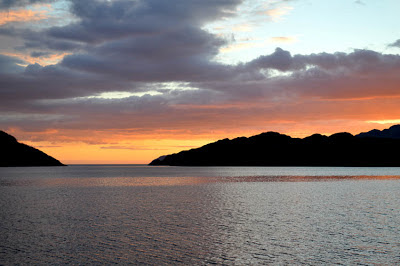 St. Kilda is a tiny remote island group that bears the brunt of ugly North Atlantic weather at a lonely spot some 50 miles to the west of the Outer Hebrides. The only landing place in the group is on Hirta in a bay that is wide open to the southeast.
St. Kilda is a tiny remote island group that bears the brunt of ugly North Atlantic weather at a lonely spot some 50 miles to the west of the Outer Hebrides. The only landing place in the group is on Hirta in a bay that is wide open to the southeast.
During our stay at Loch Skipport, we had been checking daily for a long enough period of settled [but not southeast] weather to visit Hirta. As is often the case, when we had finally given up and decided to head for Stornoway and park ourselves for a week of two in "the big city", the break finally came.
Hirta can rarely be visited by small boat in the summer and even less frequently in the winter. Surprisingly though, it was inhabited by extraordinarily hardy folk for at least 4000 years until they decided to leave the island in 1930. The people were essentially self sufficient, living mostly from the exceptionally large seabird colonies that inhabit the island group. They ate seabirds and seabird eggs, dried seabirds for winter in a type of stone drying cairn and harvested wool from the wild sheep to weave and knit clothing. The 'owner' of the islands lived on the Isle of Skye and collected rent in the form of feathers and seabird oil.
 There is still a human presence on the island in the form of Scottish National Trust caretakers, research anthropologists and the folk running a small radar site on top of the highest hill. Nonetheless, the intact abandoned stone houses, drying mounds and fences, and innumerable roaming wild Soay sheep [looking like tiny llamas] give the impression of a Scottish Macchu Picchu.
There is still a human presence on the island in the form of Scottish National Trust caretakers, research anthropologists and the folk running a small radar site on top of the highest hill. Nonetheless, the intact abandoned stone houses, drying mounds and fences, and innumerable roaming wild Soay sheep [looking like tiny llamas] give the impression of a Scottish Macchu Picchu.
You, the reader, can glean far more information by googling St. Kilda than I can provide from our rolly anchorage here in Village Bay but, as always, the impressions gleaned by being here have an immediacy not available from an armchair.
The long trip out here under sail when coupled with a bit of imagination regarding vessels available in centuries past gives a feeling for the isolation experienced by the inhabitants long ago. We arrived at 2 am with the nearby rocky island of Boreray offering a stunning silhouette against the northern midnight twilight. In the morning, the leftover swell from the previous days of heavy weather led to some effort being required to move the dinghy from deck to water. Finally though, we were able to walk through the eerie remains of the village.
By this time, a few tourist boats had arrived, the first after many days of inclement weather. The tourists, like ourselves, had to go ashore in small inflatable dinghies. No large covered boats are allowed at the pier to prevent the introduction of alien species [rats, for instance] to the island. The sheer scale of the village area easily absorbed the small number of tourists without their seeming to have any effect on the visual scene. The day was perfect with bright sunshine and little wind.
During the evening, we and a group of Scots paid reciprocal visits to each other's boats. In brief, this involved some drinks, some cake, some bagpipe, some piano and some song.
 We decided that on our second day we would climb to the hilltops that surround Village Bay for a view from above, a look into the other [larger] valley on the island and a vista of the other islands and sea stacks in the St. Kilda group. It was promised that the obscuring mist would burn off shortly under the heat of the sun.
We decided that on our second day we would climb to the hilltops that surround Village Bay for a view from above, a look into the other [larger] valley on the island and a vista of the other islands and sea stacks in the St. Kilda group. It was promised that the obscuring mist would burn off shortly under the heat of the sun.
As you no doubt fear from the preceding paragraph, the mist failed to dissipate and from an elevation of 350 meters [1150 feet] we had a view only of the grass at our feet and a surrounding white 'wall'. We waited a considerable time in the damp mist and, slightly disappointed, headed back toward the village. Half way down the hill the mist cleared to present the highlands in bright sunshine. More stalwart folks than us would have reversed course and marched back up to the hilltops ...
-----
At 30/05/2013 17:29 (utc) our position was 57°48.53'N 008°33.94'W



















